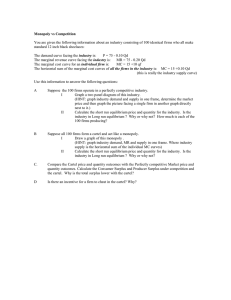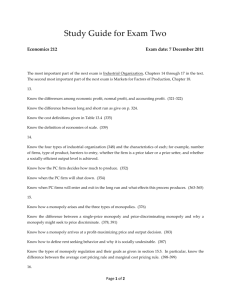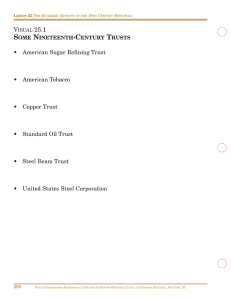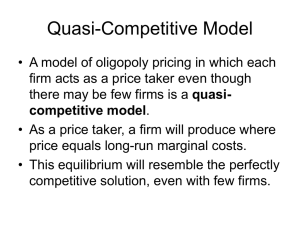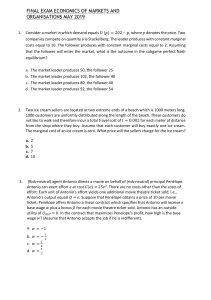Final Exam Review Part 4 KEY
advertisement
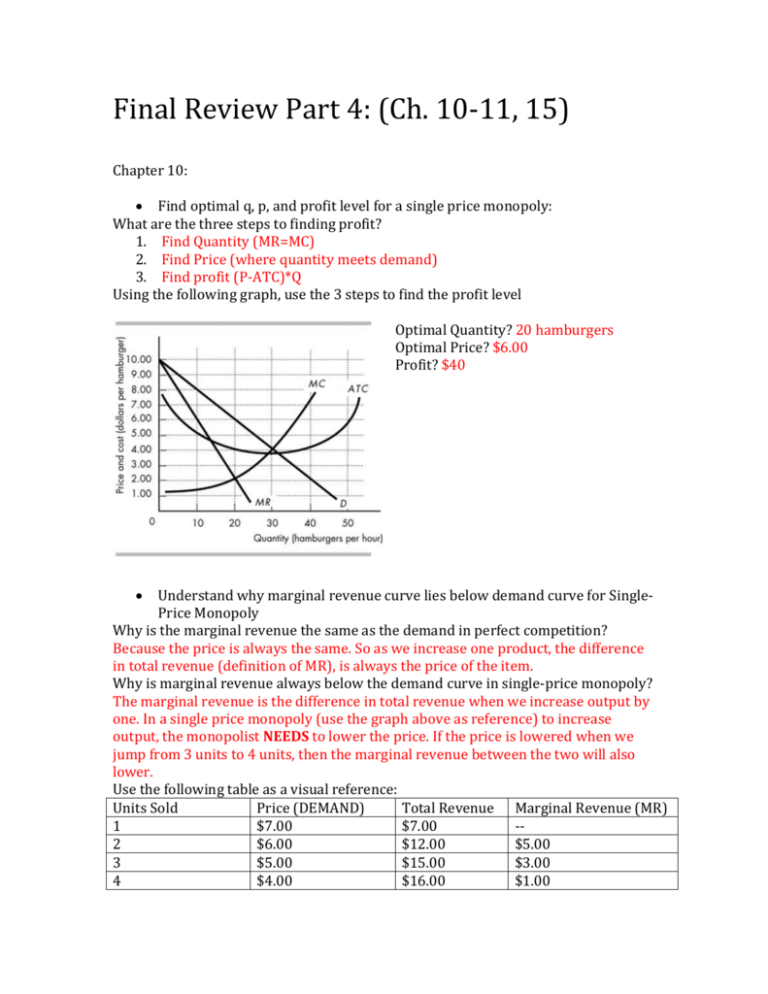
Final Review Part 4: (Ch. 10-11, 15) Chapter 10: Find optimal q, p, and profit level for a single price monopoly: What are the three steps to finding profit? 1. Find Quantity (MR=MC) 2. Find Price (where quantity meets demand) 3. Find profit (P-ATC)*Q Using the following graph, use the 3 steps to find the profit level Optimal Quantity? 20 hamburgers Optimal Price? $6.00 Profit? $40 Understand why marginal revenue curve lies below demand curve for SinglePrice Monopoly Why is the marginal revenue the same as the demand in perfect competition? Because the price is always the same. So as we increase one product, the difference in total revenue (definition of MR), is always the price of the item. Why is marginal revenue always below the demand curve in single-price monopoly? The marginal revenue is the difference in total revenue when we increase output by one. In a single price monopoly (use the graph above as reference) to increase output, the monopolist NEEDS to lower the price. If the price is lowered when we jump from 3 units to 4 units, then the marginal revenue between the two will also lower. Use the following table as a visual reference: Units Sold Price (DEMAND) Total Revenue Marginal Revenue (MR) 1 $7.00 $7.00 -2 $6.00 $12.00 $5.00 3 $5.00 $15.00 $3.00 4 $4.00 $16.00 $1.00 Definition of Price Discrimination Price Discrimination – charging different customers different prices for reasons unrelated to cost Chapter 11 Distinguish between perfect competition, monopoly, monopolistic competition, and a cartel o Perfect Competition Characteristics – no barriers to entry, standardized products, many buyers and sellers Price-_______ (price-takers) price comes from market price, no control over price for individual firms Has zero economic profits in the long run Draw and label a graph: o Monopoly Reasons for a monopoly – natural monopoly (economies of scale), might control some scarce inputs, government creates barriers to entry (patents), superior entrepreneurs Price-_______ (price-makers) control over prices Draw and label a graph: o Monopolistic Competition Characteristics – no barriers to entry, differentiated products, many buyers and sellers How does a firm in monopolistic competition find it’s price? With differentiated products, customers may have preference of one product over the other. Firm must make price based off of other firms and their products, HOWEVER it is hard to know what other firms will charge. o Cartels Arise from ____________________ and act like ________________ (perfect competition, monopolies) Definition of cartel – is an agreement between competing firms to control prices by limiting the market quantity output, by lowering quantity: they raise prices and raise revenue, and then split the high profits between them What is a “free-rider” and a cheater in a market with a cartel? “Free-rider” – someone who is not part of the cartel and does not limit/lower quantities, but still benefits from high market prices Cheater – someone who is part of the cartel and cheats by not lowering output or raising output while other firms lower output, this way they have a large portion of the market share Which is the best position to have? Free-rider Draw and label a graph: What is Nash Equilibrium? The situation in which no player has anything to gain from changing their strategy, both players walk away not regretting their decision after seeing the other player’s Find the Nash Equilibrium of each of the following: Answers: both competitive price, both fight Chapter 13 Random Walk Hypothesis – we cannot predict the price of tomorrow but there may be a general trend in stock prices Efficient Market Hypothesis – unless you have insider information, there is no strategy and no way to beat the market o What does it mean to “beat the market”? to yield a higher return than the average of everyone else’s returns Present Value o If we invest $100 at a net interest rate of 6% annually and we will have $106 next year, what is the present value of this situation? $100 o Present value is “going back in time” o What is the formula for finding present value? If you receive the entire amount in n years from now PV=FV/(1+i)^n o If you put money away in a bond that pays back 10% interest and receive the full amount of $12,000 7 years from now, what is your present value? What is the $12,000 worth to you today? Chapter 15 What are the two rationales for government intervention? 1. “Fairness issues” 2. Market failures/economic efficiency issues Fundamental Theorem of Welfare Economics a. The commodity being bought and sold is homogenous (standardized) b. The buyers are well-informed (know prices and qualities being sold) c. Many sellers, each attempting to maximize profits (implying costminimization for a given output level) d. The consumers pay the full cost of what they consume Externality – a by-product of a good or activity that affects someone not directly involved in the transaction Come up with your own examples of externalities! Second-hand smoke, loud music, pollution from motorcycles, a woman getting an education to be a public school elementary school teacher




